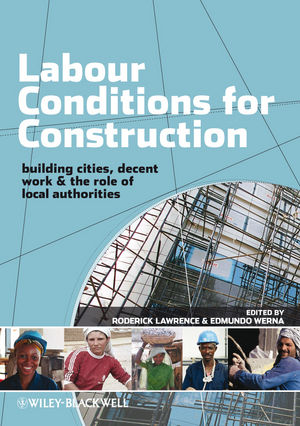Labour Conditions for Construction: Building Cities, Decent Work and the Role of Local AuthoritiesISBN: 978-1-4051-8943-9
Hardcover
312 pages
September 2009, Wiley-Blackwell
 |
||||||
Foreword by Elisabeth Gateau.
Foreword by José de Filippi Jr.
Preface.
Terms and Abbreviations.
Dedication.
Acknowledgements.
Introduction.
1 Conceptual and Methodological Issues (Roderick Lawrence and Mariana Paredes Gil).
1.1 What is decent work?
1.1.1 Origins of the concept.
1.2 Conceptual issues.
1.2.1 Interrelations between the four key components of decent work.
1.2.2 Contradictions and conflicts between components of decent work.
1.2.3 Universality of the decent work concept.
1.3 Understanding the interrelationships between employment, construction and local authorities.
1.4 Criteria for defining indicators of decent work.
1.4.1 Criteria for the construction sector.
1.4.2 Criteria for local authorities.
1.5 Research methodology.
1.5.1 Case studies in local authorities.
1.5.2 Methodology for case studies.
Notes.
2 Measuring Decent Work (Mariana Paredes Gil).
2.1 Review of proposals to measure decent work.
2.2 Indicators of the employment dimension.
2.2.1 Employment opportunities.
2.2.2 Remuneration of work.
2.2.3 Working conditions.
2.3 Indicators of the social security dimension.
2.4 Indicators of the workers’ rights dimension.
2.4.1 Forced labour.
2.4.2 Child labour.
2.4.3 Inequality at work.
2.4.4 Freedom of association.
2.5 Indicators of the social dialogue dimension.
2.6 Synthesis.
Notes.
3 Local Authorities and the Construction Industry (Mariana Paredes Gil and Edmundo Werna).
3.1 Decent work in urban areas.
3.1.1 Employment dimension.
3.1.2 Social protection.
3.1.3 Workers’ rights.
3.1.4 Social dialogue.
3.1.5 Cross-cutting analyses.
3.2 Local authorities.
3.2.1 Evolution of the role of cities in the global economy.
3.2.2 New roles for local authorities.
3.3 The construction sector.
3.3.1 The construction sector: definition and general characteristics.
3.3.2 Implications for decent work.
3.3.3 Recommendations for action.
3.4 Local authorities and decent work in the construction sector and related services.
3.5 Conclusion.
Note.
4 Bulawayo (Beacon Mbiba and Michael Ndubiwa).
4.1 Introduction.
4.2 National, regional and local context.
4.2.1 The national context.
4.2.2 Regional and local context.
4.3 Decent work indicators.
4.3.1 Indicators of employment.
4.3.2 Social security indicators.
4.3.3 Indicators of workers’ rights.
4.3.4 Indicators of social dialogue.
4.3.5 Workers’ rights and social dialogue in Zimbabwe.
4.3.6 Synthesis: decent work indicators in Bulawayo.
4.4 Decent work in place Bulawayo: initiatives and evidence.
4.4.1 Equality and the indigenization policy in the construction sector.
4.4.2 Managing centre local relations.
4.4.3 Realistic strategic planning and citizen participation.
4.4.4 The role of Bulawayo in promoting employment creation.
4.4.5 Bulawayo and the promotion of cooperatives.
4.5 Decent work: evidence, obstacles and potential.
4.5.1 Decent work and development in Zimbabwe.
4.5.2 Methodological and conceptual considerations.
4.5.3 Women’s rights at work and health and safety in the construction sector.
4.5.4 The informal economy: opportunities in Bulawayo.
4.5.5 Future activities: Bulawayo's procurement dividend and the decent work audit.
4.5.6 Obstacles and potentials for decent work promotion in Bulawayo.
Notes.
5 Dar es Salaam (Jill Wells).
5.1 Introduction.
5.1.1 Background on Tanzania.
5.2 National, regional and local context.
5.2.1 National context.
5.2.2 Economy, employment and the construction sector.
5.3 Regional and local context.
5.3.1 The evolution of local government.
5.3.2 Demographic and economic development in Dar es Salaam.
5.3.3 The growth of the informal sector.
5.3.4 Government response to growth of the informal sector.
5.3.5 Growth of informal settlements and government response.
5.4 Decent work indicators.
5.4.1 Indicators of employment.
5.4.2 Indicators of social security.
5.4.3 Indicators of workers’ rights.
5.4.4 Indicators of social dialogue.
5.4.5 Synthesis: decent work indicators in Dar es Salaam.
5.5 Decent work in Dar es Salaam: best practices.
5.5.1 Initiatives of the Dar es Salaam City Council.
5.6 Synthesis: decent work, evidence, obstacles and potentials.
5.6.1 Evidence.
5.6.2 Obstacles.
5.6.3 Potentials.
Notes.
6 Santo André (Mariana Paredes Gil).
6.1 Introduction.
6.2 National, regional and local context.
6.2.1 National context.
6.2.2 Regional and local context.
6.2.3 The informal sector.
6.3 Decent work indicators.
6.3.1 Indicators of employment.
6.3.2 Indicators of social security.
6.3.3 Indicators of workers’ rights.
6.3.4 Indicators of social dialogue.
6.3.5 Synthesis: Santo André decent work indicators.
6.4 Decent work in Santo André: best practices.
6.4.1 The ‘Santo André Mais Igual’ (SAMI) program.
6.4.2 The Public Centre for Employment, Labour and Income (CPETR).
6.4.3 Integrated Program for Qualification, PIQ (Programa Integrado de Qualificação).
6.4.4 Selective Collection and Income.
Generation Program.
6.5 Decent work: synthesis and recommendations.
Notes.
7 Conclusions and Recommendations (Roderick Lawrence, Yves Flückiger, Cedric Lambert, Mariana Paredes Gil and Edmundo Werna).
7.1 General findings.
7.2 Recommendations and guidelines.
7.3 Conclusion.
References.
Index.



